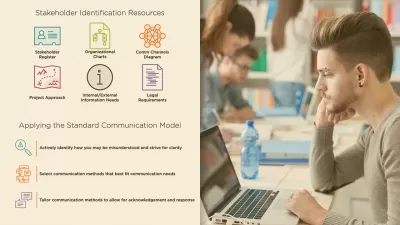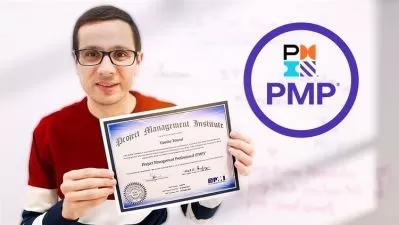PMP Certification - Complete Exam Prep Course Bundle
EDUCBA Bridging the Gap
40:20:49
Description
Don't Just Learn the Project Management, Become Job-Ready and Pass the PMP exam in one go.
What You'll Learn?
- Introduction to the PMP certification exam. Exam prep tips. Updates on the examination. Types of questions. Application prerequisites.
- Introduction to project management. Definition of management. Overview of project life cycles. Role of a project manager.
- Understanding project management knowledge areas.
- Specifics on developing a project management plan, managing project knowledge, integrated change control, collecting requirements, creating a WBS etc
- Introduction to Agile methodology. Overview of Agile principles. Explanation of Scrum, roles, responsibilities, stakeholder engagement, Agile charter etc
- Overview of the Program Manager's mindset. Consideration of professional ethics. Integration, schedule, and communications
Who is this for?
What You Need to Know?
More details
DescriptionThe Project Management Professional (PMP) certification exam is a globally recognized and highly demanded credential for project managers. Administered by the Project Management Institute (PMI), the PMP certification is considered the gold standard in project management.
Key points about the PMP Certification Exam:
Recognition and Demand: The PMP certification is widely recognized and sought after by organizations worldwide. It validates an individual's competence to lead projects and teams effectively in the role of a Project Manager.
Global Scope: PMP-certified professionals can be found leading projects in nearly every country. The certification has a global appeal, making it valuable for project managers working in diverse international settings.
Formal Credential: The PMP certification is the second of three formal credentials administered by the PMI. It signifies a project manager's commitment to professional development and adherence to industry standards.
Obtaining the PMP certification involves passing a rigorous exam that assesses a candidate's knowledge and skills in various aspects of project management, as outlined by the PMI's Project Management Body of Knowledge (PMBOK).
The eligibility requirements and steps for applying for the Project Management Professional (PMP) certification. Here's a summary:
Eligibility Requirements: To be eligible for the PMP certification, candidates must meet the following requirements:
Possess a secondary degree, such as a high school diploma, associate’s degree, or equivalent.
Accumulate a minimum of five years of project management experience.
Acquire hands-on experience by leading and directing projects during the five years.
Log a minimum of 7,500 hours actively involved in leading and directing projects.
Emphasis on practical experience to apply theoretical project management concepts in real-world scenarios.
How to Apply for PMP Certification – Step-by-Step Guide:
Check Your Eligibility:
Ensure that you meet all eligibility criteria, including project management education and work experience.
Create Your PMI Account:
Visit pmi. org and create an account to access necessary forms and resources for the application.
Complete the Online Application:
Fill out the PMP certification application thoroughly with accurate and well-documented information.
Submit Your Application:
Review your application carefully before submitting it online through PMI's website.
Pay Examination Fee:
After PMI accepts your application, follow online instructions to pay the examination fee.
Schedule Your Exam:
Upon fee payment, schedule your exam at one of PMI's authorized testing centers based on availability and convenience.
Following these steps will streamline the PMP certification application process and bring you closer to achieving this esteemed credential. It's a significant milestone in your career journey, and preparation is key to success. Good luck on your PMP certification journey!
Great tips for preparing for the PMP exam! Here's a summarized version:
Tips for Preparing for the PMP Exam:
Understand the Exam Format:
The PMP exam consists of 200 multiple-choice questions based on the PMBOK Guide and distributed across five process groups.
Review the PMBOK Guide:
Familiarize yourself with the PMBOK Guide, emphasizing key concepts, processes, and ITTOs (Inputs, Tools & Techniques, Outputs).
Create a Study Plan:
Develop a study plan with dedicated time for preparation, setting achievable goals and milestones to track progress.
Utilize Reliable Study Materials:
Use reputable materials like textbooks, online courses, practice exams, and reference guides designed for PMP certification preparation.
Take Practice Exams:
Practice with mock exams to simulate real conditions, identify areas for improvement, and strengthen your skills.
Join Study Groups or Forums:
Engage with other PMP aspirants in study groups or online forums to gain insights and support throughout your preparation.
Apply PMBOK Concepts Practically:
Apply project management concepts in real-life scenarios to solidify your understanding of principles.
Time Management is Key:
Develop good time management habits during preparation to allocate time effectively during the exam.
Remember to meet eligibility requirements, create a focused study plan, and use reliable materials. Taking practice exams, understanding the question format, and managing time effectively during the test are crucial. Joining study groups can provide additional insights and support. Best of luck on your PMP certification journey!
Find below outline of topics related to PMP (Project Management Professional) certification. Here's a brief overview based on the outlined sections:
1. PMP Examination Overview:
Introduction to the PMP certification exam.
Exam prep tips.
Updates on the examination.
Types of questions.
Application prerequisites.
Examples from PMI. ORG.
Tips for the exam.
2. Domains and Their Associated Tasks:
Overview of the PMP exam outline domains.
Detailed breakdown of Domain 1 (People) and Domain 2 (Process).
Exploration of Domain 3 (Business Environment).
3. Defining Project Management:
Introduction to project management.
Definition of management.
Overview of project life cycles.
Role of a project manager.
4. Project Management Knowledge Areas:
Understanding project management knowledge areas.
Specifics on developing a project management plan, managing project knowledge, integrated change control, collecting requirements, creating a WBS, project scheduling management, and more.
5. Agile Management:
Introduction to Agile methodology.
Overview of Agile principles.
Explanation of Scrum, roles, responsibilities, stakeholder engagement, Agile charter, and communication types.
Problem-solving in Agile.
6. The Program Manager's Mindset:
Overview of the Program Manager's mindset.
Consideration of professional ethics.
Integration, schedule, and communications in the program manager's mindset.
It covers a comprehensive range of topics related to PMP certification, including examination details, project management fundamentals, knowledge areas, Agile methodologies, and the program manager's mindset.
Who this course is for:
- Project Managers: This PMP course is designed for Project Managers, who want to apply a standards-based approach to project management and desire to increase their project management skills. The course is best suited for project managers.
- Professionals: Professionals who want to become a project manager can apply for this course.
The Project Management Professional (PMP) certification exam is a globally recognized and highly demanded credential for project managers. Administered by the Project Management Institute (PMI), the PMP certification is considered the gold standard in project management.
Key points about the PMP Certification Exam:
Recognition and Demand: The PMP certification is widely recognized and sought after by organizations worldwide. It validates an individual's competence to lead projects and teams effectively in the role of a Project Manager.
Global Scope: PMP-certified professionals can be found leading projects in nearly every country. The certification has a global appeal, making it valuable for project managers working in diverse international settings.
Formal Credential: The PMP certification is the second of three formal credentials administered by the PMI. It signifies a project manager's commitment to professional development and adherence to industry standards.
Obtaining the PMP certification involves passing a rigorous exam that assesses a candidate's knowledge and skills in various aspects of project management, as outlined by the PMI's Project Management Body of Knowledge (PMBOK).
The eligibility requirements and steps for applying for the Project Management Professional (PMP) certification. Here's a summary:
Eligibility Requirements: To be eligible for the PMP certification, candidates must meet the following requirements:
Possess a secondary degree, such as a high school diploma, associate’s degree, or equivalent.
Accumulate a minimum of five years of project management experience.
Acquire hands-on experience by leading and directing projects during the five years.
Log a minimum of 7,500 hours actively involved in leading and directing projects.
Emphasis on practical experience to apply theoretical project management concepts in real-world scenarios.
How to Apply for PMP Certification – Step-by-Step Guide:
Check Your Eligibility:
Ensure that you meet all eligibility criteria, including project management education and work experience.
Create Your PMI Account:
Visit pmi. org and create an account to access necessary forms and resources for the application.
Complete the Online Application:
Fill out the PMP certification application thoroughly with accurate and well-documented information.
Submit Your Application:
Review your application carefully before submitting it online through PMI's website.
Pay Examination Fee:
After PMI accepts your application, follow online instructions to pay the examination fee.
Schedule Your Exam:
Upon fee payment, schedule your exam at one of PMI's authorized testing centers based on availability and convenience.
Following these steps will streamline the PMP certification application process and bring you closer to achieving this esteemed credential. It's a significant milestone in your career journey, and preparation is key to success. Good luck on your PMP certification journey!
Great tips for preparing for the PMP exam! Here's a summarized version:
Tips for Preparing for the PMP Exam:
Understand the Exam Format:
The PMP exam consists of 200 multiple-choice questions based on the PMBOK Guide and distributed across five process groups.
Review the PMBOK Guide:
Familiarize yourself with the PMBOK Guide, emphasizing key concepts, processes, and ITTOs (Inputs, Tools & Techniques, Outputs).
Create a Study Plan:
Develop a study plan with dedicated time for preparation, setting achievable goals and milestones to track progress.
Utilize Reliable Study Materials:
Use reputable materials like textbooks, online courses, practice exams, and reference guides designed for PMP certification preparation.
Take Practice Exams:
Practice with mock exams to simulate real conditions, identify areas for improvement, and strengthen your skills.
Join Study Groups or Forums:
Engage with other PMP aspirants in study groups or online forums to gain insights and support throughout your preparation.
Apply PMBOK Concepts Practically:
Apply project management concepts in real-life scenarios to solidify your understanding of principles.
Time Management is Key:
Develop good time management habits during preparation to allocate time effectively during the exam.
Remember to meet eligibility requirements, create a focused study plan, and use reliable materials. Taking practice exams, understanding the question format, and managing time effectively during the test are crucial. Joining study groups can provide additional insights and support. Best of luck on your PMP certification journey!
Find below outline of topics related to PMP (Project Management Professional) certification. Here's a brief overview based on the outlined sections:
1. PMP Examination Overview:
Introduction to the PMP certification exam.
Exam prep tips.
Updates on the examination.
Types of questions.
Application prerequisites.
Examples from PMI. ORG.
Tips for the exam.
2. Domains and Their Associated Tasks:
Overview of the PMP exam outline domains.
Detailed breakdown of Domain 1 (People) and Domain 2 (Process).
Exploration of Domain 3 (Business Environment).
3. Defining Project Management:
Introduction to project management.
Definition of management.
Overview of project life cycles.
Role of a project manager.
4. Project Management Knowledge Areas:
Understanding project management knowledge areas.
Specifics on developing a project management plan, managing project knowledge, integrated change control, collecting requirements, creating a WBS, project scheduling management, and more.
5. Agile Management:
Introduction to Agile methodology.
Overview of Agile principles.
Explanation of Scrum, roles, responsibilities, stakeholder engagement, Agile charter, and communication types.
Problem-solving in Agile.
6. The Program Manager's Mindset:
Overview of the Program Manager's mindset.
Consideration of professional ethics.
Integration, schedule, and communications in the program manager's mindset.
It covers a comprehensive range of topics related to PMP certification, including examination details, project management fundamentals, knowledge areas, Agile methodologies, and the program manager's mindset.
Who this course is for:
- Project Managers: This PMP course is designed for Project Managers, who want to apply a standards-based approach to project management and desire to increase their project management skills. The course is best suited for project managers.
- Professionals: Professionals who want to become a project manager can apply for this course.
User Reviews
Rating
EDUCBA Bridging the Gap
Instructor's Courses
Udemy
View courses Udemy- language english
- Training sessions 289
- duration 40:20:49
- Release Date 2024/06/25
















